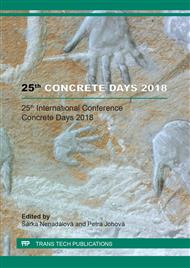p.40
p.45
p.50
p.56
p.63
p.69
p.79
p.85
p.91
Fracture Response of Fine-Grained Cement-Based Composite Specimens with Special Inclusions
Abstract:
This paper concerns research into the importance of the interfacial transition zone around inclusions of selected materials in fine-grained cement-based composite. Tests were performed on eight sets of prismatic test specimens. The sets differed in the inclusion materials used, which were placed at midspan above the initial central edge notch. The first was a reference set without any inclusion, the second contained a steel inclusion, four more contained different types of rock inclusion, the seventh contained an inclusion of extruded polystyrene, and the last contained a space of the same dimensions as that occupied by the inclusions in sets 2 to 7. The test specimens were subjected to three-point bending fracture tests at the age of (usually) 28 days. The fracture response was analysed by means of fracture mechanics theory, and apparent mechanical fracture parameters (modulus of elasticity, fracture toughness and fracture energy) were evaluated. The conclusion shows that a possible relationship exists between the differences in the mechanical fracture parameters of specimens with/without an inclusion and the existence of the interfacial transition zone.
Info:
Periodical:
Pages:
63-68
Citation:
Online since:
June 2019
Price:
Сopyright:
© 2019 Trans Tech Publications Ltd. All Rights Reserved
Share:
Citation:


